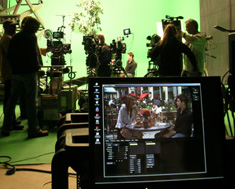Guest blogger: John Cohn ’81, IBM Fellow at IBM Systems and Technology Group

On the show, John Cohn ’81 (above) built numerous devices to aid the colonists' survival, including water purifiers, a wood-powered electric generator, and flame throwers. The opportunity to spend all day inventing on the fly was, despite the conditions and some reality-TV drama, one of the most fun and relaxing things he's ever done. Photo: Discovery Channel.
Ever wanted to be on TV? Here’s your chance! Last year I was a cast member on The Colony, a new science/survival/reality show on Discovery Channel. The show simulates a post-apocalyptic world in which a small group of people is isolated in a constrained setting and has to innovate in order to survive. Think Survivor meets MacGyver. Watch video from the show to get a feel for the setup.
Last year, 10 of us were isolated in an abandoned steel mill in East LA for 58 days. We had to develop ways to purify water, find and prepare food, generate electricity, communicate, and even defend ourselves from simulated attackers using just the materials we could find. The experience was not for the feint of heart—we worked long hours; ate, drank, and slept very little; and were perpetually dirty. But even so, it was one of the most incredible experiences of my life on both a technical and personal level.
Reaction to the series was very positive. Discovery called it a “surprise hit” and are now casting for season two. They’ve asked me to help find the perfect mad scientist type. Do you have mad talents like circuit hacking, welding, woodworking, and fire skills? Do you have crazy survival tactics? Leadership ability? What do you think you’d bring to a post-apocalyptic world? We’re looking for Mad Max with a brass rat. Is that you? If so, please contact me johncohn@alum.mit.edu and visit Metal Flowers Media and get your application in right away. Also, feel free to contact me if you have any questions.
I’d love to see another person from the ’Tute show the world what it takes to survive the big one!
Here’s the casting notice:
THE COLONY
The Discovery Channel invites you to participate in an extraordinary, once-in-a-lifetime experience: in the second season of this critically acclaimed docu-reality series deemed a social experiment, a group of eleven strangers must co-exist in a simulated, post-apocalyptic world. The world as you know it is gone there is no water, no food, no communication, no power. Its now up to you and eleven strangers to fend for yourselves as you rebuild society and re-engineer the world as you once knew it.
If you understand the science of survival, if you have a skill that would help you and others survive after a catastrophe, if you are ambitious, motivated, resourceful under pressure and willing to un-tap your personal ingenuity, we are looking for you. Join us in this true test of the human spirit.
Must have TANGIBLE survival skills and big personalities.
Editor’s note:
In honor of the upcoming national Engineers’ Week, February 14–20, Cohn put together and stars in this humorous rap parody to remind folks that engineering is wicked cool. Also check out Cohn’s blog, which he began as a way to help cope with the death of his 14-year-old son, Sam, killed in a 2006 traffic accident.







